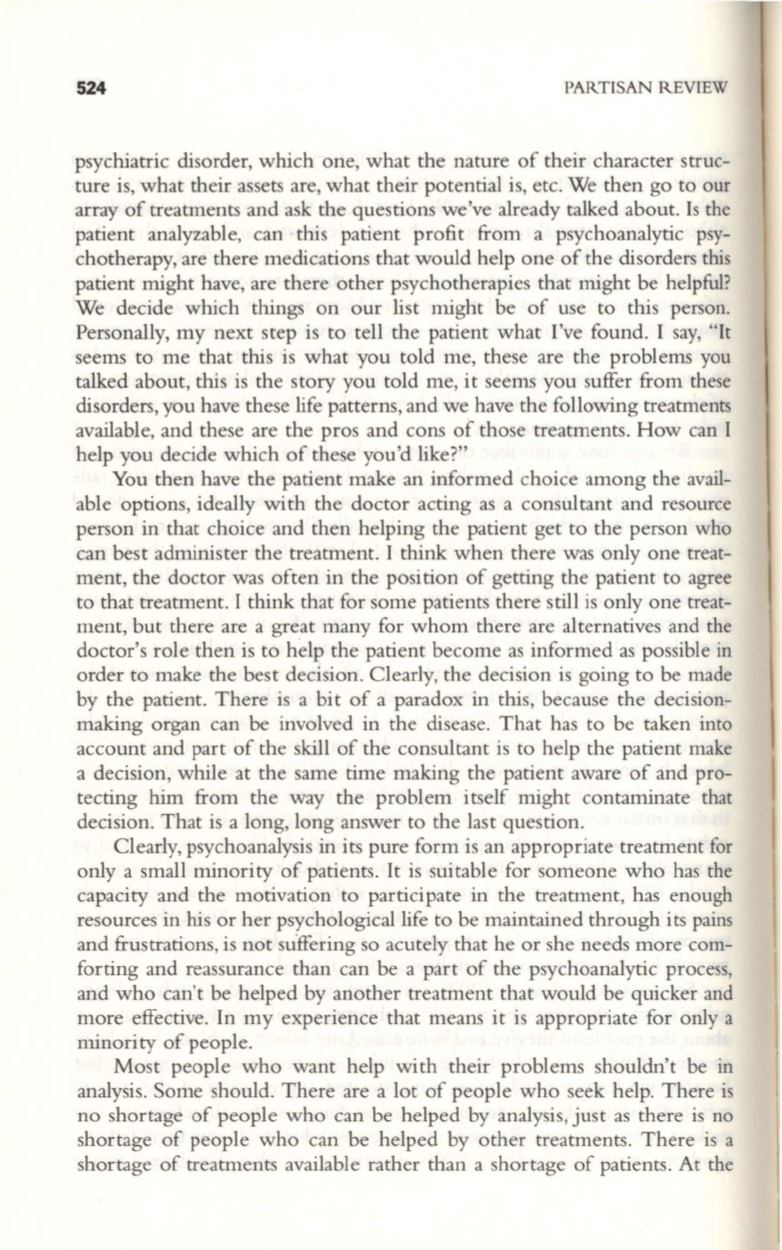
524
PARTISAN REVIEW
psychiatric disorder, which one, what the nature of their character struc–
ture is, what their assets are, what their potential is, etc. We then go to our
array of treatments and ask the questions we've already talked about. Is the
patient analyzable, can this patient profit from a psychoanalytic psy–
chotherapy, are there medications that would help one of the disorders this
patient might have, are there other psychotherapies that might be helpful?
We decide which things on our list might be of use to this person.
Personally, my next step is to tell the patient what I've found. I say,
"It
seems to me that this is what you told me, these are the problems you
talked about, this is the story you told me, it seems you suffer from these
disorders, you have these life patterns, and we have the following treatments
available, and these are the pros and cons of those treatments. How can I
help you decide which of these you'd like?"
You then have the patient make an informed choice among the avail–
able options, ideally with the doctor acting as a consultant and resource
person in that choice and then helping the patient get to the person who
can best administer the treatment. I think when there was only one treat–
ment, the doctor was often in the position of getting the patient to agree
to that treatment. I think that for some patients there still is only one treat–
ment, but there are a great many for whom there are alternatives and the
doctor's role then is to help the patient become as informed as possible
in
order to make the best decision. Clearly, the decision is going to be made
by the patient. There is a bit of a paradox in this, because the decision–
making organ can be involved in the disease. That has to be taken into
account and part of the skill of the consultant is to help the patient make
a decision, while at the same time making the patient aware of and pro–
tecting him from the way the problem itself might contaminate that
decision. That is a long, long answer to the last question.
Clearly, psychoanalysis in its pure form is an appropriate treatment for
only a small minority of patients. It is suitable for someone who has the
capacity and the motivation to participate in the treatment, has enough
resources in his or her psychological life to be maintained through its pains
and frustrations, is not su'ffering so acutely that he or she needs more com–
forting and reassurance than can be a part of the psychoanalytic process,
and who can't be helped by another treatment that would be quicker and
more effective. In my experience that means it is appropriate for only a
minority of people.
Most people who want help with their problems shouldn't be
in
analysis. Some should. There are a lot of people who seek help. There is
no shortage of people who can be helped by analysis, just as there is no
shortage of people who can be helped by other treatments. There is a
shortage of treatments available rather than a shortage of patients. At the


